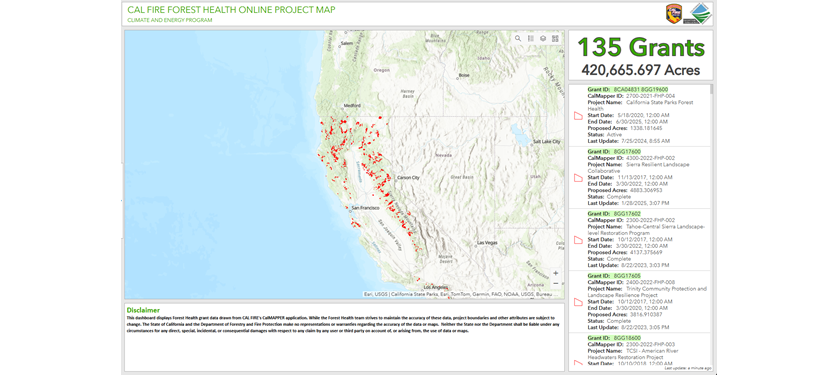Forest Health
CAL FIRE’s Forest Health Program works with local partners to improve forest health and reduce greenhouse gas emissions in forests throughout California.
The Forest Health Program is part of CAL FIRE’s Climate and Energy Program and addresses the risk to California’s forests from extreme disturbance events including catastrophic wildfires, drought, and pest mortality. These events are the result of climate change, forest overcrowding, past land management practices, and an increasing number of people living in the wildland and urban interface.
The Forest Health Program is responsible for administering Forest Health grants, piloting a regional grant program to build capacity and scale up investments across the state, and implementing a monitoring program to better understand the outcomes of grant-funded activities.
Our Program at Work
The Forest Health Program supports landscape restoration projects to improve forest resilience, sequester carbon, and protect communities.
CAL FIRE has awarded more than $630 million in Forest Health grants to 137 projects through 2024. Collectively, these projects will treat more than 460,000 unique acres across the state and are anticipated to store nearly 15 million tons of carbon dioxide equivalent over their lifetimes.
Cultural Burning & Fuels Reduction
Grantee: Humboldt County Resource Conservation District
FY 19/20 Grant Amount: $4,315,392
Acres of Fuel Reduction: 1,159
Acres of Prescribed Burn: 1,313
GHG Benefit (MT CO2e): 57,625
Humboldt County Resource Conservation District is working with the Yurok Tribe and Western Rivers Conservancy to implement forest management activities on 2,400 acres of Yurok ancestral lands. The collaborative project will reduce fuel loads, retain the healthiest and largest trees, allow the return of cultural burning to the landscape, improve wildlife and fisheries habitat, and create employment opportunities for Yurok Tribe members. Read More
Tribal Workforce Forest Restoration
Grantee: Fire Safe Council of San Diego
FY 19/20 Grant Amount: $4,994,675
Acres of Fuel Reduction: 1,059
Number of Trees Planted: 41,475
GHG Benefit (MT CO2e): 60,895
The Fire Safe Council of San Diego County, in partnership with the Pauma Band of Luiseño Mission Indians, La Jolla Band of Luiseño Indians, Cleveland National Forest, and CalTech’s Palomar Mountain Observatory, is performing fuels reduction, pest management, and forest restoration across 1,600 acres on Palomar Mountain – one of San Diego County’s last mixed conifer forest landscapes. The project is providing multiple training avenues for Tribal youth and other Tribal members by engaging them in monitoring and implementation activities. Read More
Email: ForestHealth@fire.ca.gov
